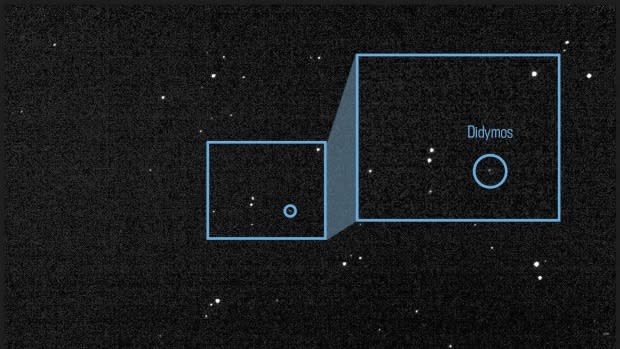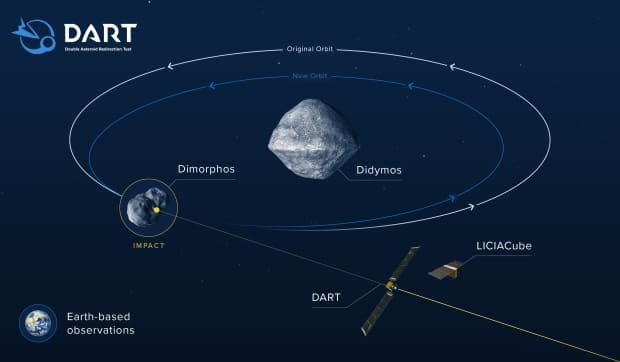NASA is slamming a spacecraft into an asteroid on Monday to test planetary defence

(UPDATE: NASA's DART spacecraft struck Asteroid Dimorphos on Monday. Full story is here.)
On Monday, in what seems like a scene out of a science fiction movie, NASA will slam a spacecraft into a distant asteroid to see whether it can nudge its orbit — all in an effort to test a way to protect Earth from any potential future threats.
The good news is that there's no need to panic: The asteroid, which is part of a binary — or two-bodied — system, is not a threat to our planet, and there are no known ones that are headed our way for at least the next 100 years. However, space agencies like the U.S. National Aeronautics and Space Administration want to be prepared should there ever be a threat.
NASA's Double Asteroid Redirection Test (DART) is testing a way in which a spacecraft may be able to nudge an asteroid on a collision course with Earth out of its orbit.
At 7:14 p.m. ET on Monday, the refrigerator-sized spacecraft will plunge itself into Dimorphos — a moonlet that orbits its larger companion, Didymos — at roughly 6.6 km/s.
The goal isn't to knock Dimorphos out of orbit but rather to change its 12-hour orbit around Didymos by 10 minutes. This means that scientists will know within roughly 12 hours whether they were successful.
So why target a binary asteroid system rather than a single asteroid to see whether you can change its orbit around the sun?
WATCH LIVE | NASA feed of DART's impact with asteroid Dimorphos
"A binary system was perfect for this test," said Mallory DeCoster, a senior scientist at Johns Hopkins University's Applied Physics Laboratory in Maryland and part of the DART Impact Modeling Working Group.
For one, the size of Dimorphos — about 164 metres across — is perfect to illustrate whether this would be an effective way of deflecting asteroids that pose a threat to Earth. Didymos is 780 metres across.
"But then the other piece is, if we were to impact a single asteroid, in order to characterize if we changed its orbit, we would have to wait until it completed its orbit around the sun, which could take many, many years."

The other advantage is that the binary system is relatively close to us, astronomically speaking, at just 11 million kilometres away.
Shooting gallery
NASA's Center for Near-Earth Object Studies says that more than 90 per cent of near-Earth objects (NEOs) bigger than one kilometre have already been discovered. But that doesn't mean we're out of the woods when it comes to Potentially Hazardous Asteroids (PHAs).
In 2013, the Chelyabinsk asteroid — which was roughly 20 metres in diameter— exploded over parts of Russia, injuring about 1,000 people and serving as a reminder of how even a small asteroid can be dangerous.

Basically, Earth flies through a shooting gallery in space. There are small chunks of debris that burn up in our atmosphere as meteors; bigger ones, like Chelyabinsk; and then even bigger ones that can be catastrophic — all left over from the formation of our solar system.
That's why space agencies like NASA and the European Space Agency have been trying to develop ways to deflect or nudge a PHA so that its orbit changes and poses no threat to Earth.
Mike Daly, a professor at York University's Lassonde School of Engineering in Toronto and a co-investigator on DART, said one of the most popular concepts is deflecting asteroids before they become a real threat. But that means we need to have advance warning that one is headed our way.
"So the simplest method is the one that DART is doing, which is essentially to take a spacecraft at high speed and crash it into the asteroid and use that transfer of the energy from the spacecraft to the asteroid to move it along," he said.

However, the science behind asteroid deflection in this manner is about more than just the combination of the spacecraft's size and incredibly high speed, called a hypervelocity impact.
"In a hypervelocity impact, you induce this pressure wave into the target that causes a lot of new physics to happen," Johns Hopkins University's DeCoster said.
"So what will happen, or what we think will happen, is that the size of the spacecraft might actually not matter that much. It might actually be: How does the asteroid respond to this pressure wave that is induced due to the hypervelocity impact? And we think that it will likely spew out a lot of material in the form of ejecta. And this ejecta might actually have a major component for changing the orbit. So much ejecta might get spewed out that that piece might matter more than the incoming energy from the spacecraft in changing its orbit."
The DART team hopes that an onboard camera, called DRACO, will show the close approach and then suddenly go black, which would be indicative of an impact.

But there's a straggler tagging along behind DART, by about three minutes: the Italian Space Agency's Light Italian Cubesat for Imaging of Asteroids, or LICIACube. Its job is to photograph the impact, study the plume of ejecta and help determine the morphology of the asteroid, as they can be made of iron, rock or just rocky clumps held together by gravity.
As this is the first test of a form of planetary defence, scientists are eagerly anticipating not only the impact of the event itself but what they will learn from it and, most importantly, what this may mean for the future of protecting Earth in the future. Telescopes from around the world will be observing the event and collecting followup data.
"We're really the first generation that can protect ourselves from these potentially catastrophic impacts," York University's Daly said. "And, you know, fortunately the really catastrophic ones don't happen very often, but they could happen, and never before have we been able to change our fate. So I think it's really up to us, given the potentially large consequences of not paying attention and our ability to do it."
The event will be broadcast on NASA TV, which is available online and through its app.

